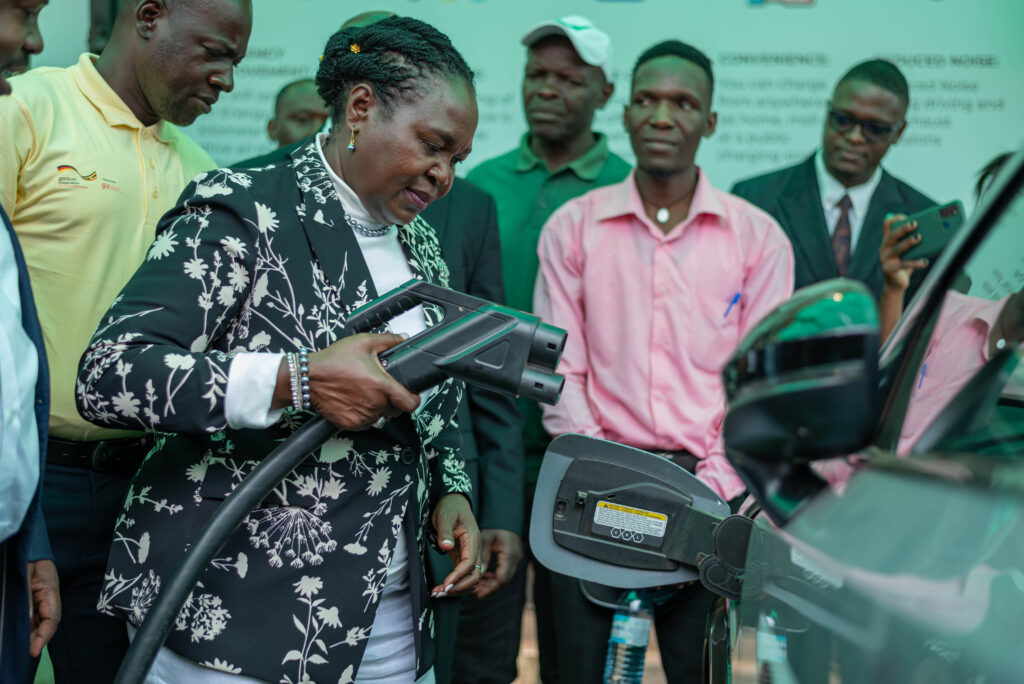Uganda has taken a step toward sustainable transportation with the launch of its first public electric vehicle (EV) charging station at Amber House in Kampala. This milestone, spearheaded by the Ministry of Energy and Mineral Development, is not just an infrastructure upgrade; it raises a crucial question: Will this pioneer move trigger a nationwide shift toward e-mobility?
The transport sector in Africa is a major contributor to carbon emissions, accounting for approximately 10% of total emissions. With Sub-Saharan Africa’s vehicle market projected to grow from 25 million in 2021 to over 58 million by 2040, the need for cleaner alternatives is becoming more urgent. Uganda’s investment in EV infrastructure signals its ambition to lead Africa’s green transition.
At Amber House, the pilot charging station is equipped with two DC fast chargers that can deliver power outputs between 30kW and 360kW, allowing an EV to recharge in as little as 15 minutes. As Uganda’s EV fleet expands, now numbering nearly 3,000 electric motorcycles, cars, and buses, this facility sets a precedent for the future.
Speaking at the launch event, Minister of Energy and Mineral Development Ruth Nankabirwa highlighted the significance of this development:
“The shift to electric vehicles offers numerous advantages, including lower fuel costs, reduced maintenance expenses, and, most importantly, a cleaner and greener future.”
While this first public EV station is a major step forward, the real test lies in whether it will inspire a broader transition across Uganda. Several factors will determine whether the Amber House station marks the beginning of a nationwide e-mobility revolution or remains an isolated project.
The Ugandan government has demonstrated its commitment to e-mobility by introducing policies aimed at reducing EV costs and expanding charging infrastructure. Simon Kalanzi, a representative from the Ministry of Energy’s Permanent Secretary’s office, reinforced this commitment:
“With fast-charging stations now operational, the government is taking a direct lead in sustainable mobility through its energy policy and efficiency initiatives.”
However, policy clarity and execution will be key. The absence of a comprehensive regulatory framework has slowed private sector investment. Will the government introduce clear incentives—such as tax breaks, subsidies, and import duty reductions—to make EVs more attractive to consumers?
A single charging station in Kampala will not be enough to drive a national transition. Expanding the charging network—especially along major highways and in other cities—will require private sector participation.
The government recognizes this and is actively engaging businesses. Kalanzi noted:
“We are collaborating with private sector partners to attract investments in sustainable mobility and energy-saving solutions.”
The question remains: Will businesses see the economic potential in Uganda’s EV market and invest at scale?
A major obstacle to widespread EV adoption in Uganda is the high upfront cost of electric vehicles. However, the long-term savings are significant.
At the launch event, an energy expert explained:
The total cost of ownership of an electric vehicle—including purchase, maintenance, and operation—is approximately 60% of that of a diesel equivalent. “The energy cost of EVs is only 20-22% of petrol or diesel costs.”
To accelerate adoption, financial institutions are stepping in. NCBA Bank Uganda’s Head of Asset Finance, Adad Iraguha, announced the bank’s commitment to financing e-mobility:
“As a bank, we are ready to provide affordable financing options at low-interest rates for Ugandans looking to purchase electric vehicles and bikes.”
Despite these promising developments, will lower financing costs and long-term savings be enough to convince consumers to make the switch?
For Uganda to see a true nationwide shift, charging stations must expand beyond the capital. Currently, the lack of charging infrastructure outside Kampala makes long-distance EV travel impractical.
Without a broader network of charging stations in major towns and highways, EV adoption may remain restricted to urban elites rather than becoming a nationwide movement.
The launch of the first public EV charging station at Amber House is a historic step, but its success will depend on how the government, private sector, and financial institutions work together to address key challenges.
The government’s policies, private investment, affordability of EVs, and nationwide charging infrastructure expansion will determine whether Uganda is on the verge of a true EV revolution or whether this remains an isolated project in Kampala.
As the world moves toward sustainable mobility, Uganda’s early investment in EV infrastructure is a sign of its readiness to embrace the future. The question now is:
Will this first charge station at Amber House be the spark that ignites a nationwide shift?


